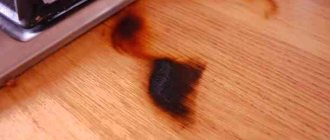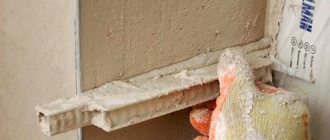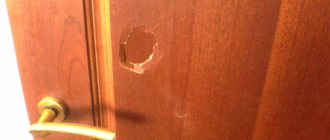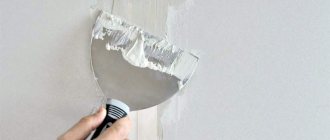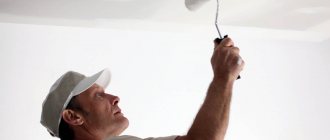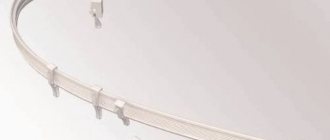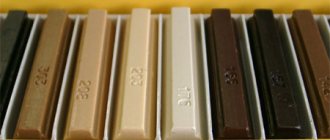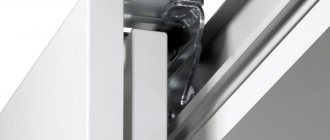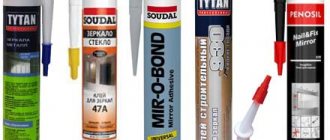Required Tools
The main tool for repairing linoleum is a knife. A dull knife cannot cut even thin material. Construction stores sell special tools for PVC coatings.
- Universal knife. They cut the fabric in a straight line, cut off the frayed edge, and cut out a patch of the desired shape. The blades on the knife are changed. They are made of durable, unbreakable and inflexible material. The blade is held in the handle by a screw. The multi-layer fabric can be easily and evenly cut with a universal tool.
- Retractable reinforced knife. It has a durable anatomical handle and a strong, unbending blade. Easily cuts multilayer linoleum, both straight and at an angle. They cut material in hard-to-reach areas.
- Disc knife. The instrument has a sharp round blade. The canvas is cut straight or along a curved contour, which is convenient for cutting irregularly shaped patches. Using a knife, linoleum is trimmed at thresholds, near niches, ledges, and communication passages.
- Knife in the shape of a month. With a curved blade, it is easy to remove dried glue residues, trim cuts, and remove burrs on the edge of the material. You can make minor repairs to linoleum and smooth out loose seams.
In addition to cutting tools, you need tools for applying markings (ruler with marker) and glue (spatula and roller).
To repair large holes, you need a linoleum patch of the same type as the damaged one. It is difficult to find the same material in the store. When laying a new coating, it is better not to throw away its remains so that you can later use them instead of a patch.
Types of damage
The method of repair work is chosen based on the origin of the damage.
- The patch has small and large torn holes.
- Scratches, cracks - putty, sealant.
Burnt
Take the remaining linoleum scrap. We make a pattern. We cut out a triangle from a new piece according to the pattern. We fix it tightly on the burned area with tape. We received two layers of coating. Cut out both layers. We cut 1-2 centimeters larger than the hole. We take out the pieces of linoleum. Let's coat the floor and the new patch with glue. Place it firmly on the base. Carefully smooth out the edges of the patch. Cold weld along the seams. Wipe off any remaining mixture with a cloth.
Large holes can also be patched this way.
Important: When cutting out a patch, make sure that one of the sides of the cut lies along the canvas. The seams are not located across the fibers. Therefore, we design the piece in the form of a triangle, rather than a circle and a square.
Breakthrough
More often, holes occur on inexpensive types of linoleum, or if it is not glued to the base. If the torn part fits well in its original place, then you need to put the torn part on double-sided tape. First you should vacuum the hole. We push the piece into place and press it tightly. We seal the seams by cold welding.
How can you seal torn linoleum?
Glue or tape will help fix the patch and joints of the separated linoleum. The latter can be either painting or ordinary. The flooring can be glued together using glue or cold welding.
- Bustilate is universal. PVC material is glued to a fabric or felt backing. They are used to glue canvases to wooden or concrete floors, plywood and other porous surfaces.
- PVA for linoleum. Canvases with or without a base are glued to any porous substrate, including chipboard, fiberboard, screed or plank flooring.
- Homakoll. Product for coverings with fabric, fluff or foam backing. Linoleum is laid on a concrete screed, wooden boards, plywood and fiberboard.
- AdesilexG. Reactive adhesive based on polyurethane. Can be glued to absorbent and non-absorbent materials. Can be used in damp areas.
- Homakoll S. Seams seams (joints), repairs minor damage such as punctures, small cuts with a smooth edge.
Scratches, burns and small punctures are repaired with mastic or polymer putty. To ensure that the adhesive seams match the color of the linoleum, fine crumbs scraped off from its remains are added to the glue.
There are repair kits that include mastic, solvent, and dye. With them, any minor defect will become almost invisible.
Details
How to fill a hole in the floor
To restore flooring with large holes, you need pieces of similar material of the required size. When purchasing, consultants often advise buying linoleum with a reserve. To secure a patch or join panels that have come apart, you also need to prepare double-sided or simple glue or tape. Double-sided fabric-based adhesive tape helps when restoring the floor. To repair roll-type coatings, I use special adhesives:
- Universal Bustilat - this adhesive composition is suitable for repairing damage to PVC linoleum made on both felt and fabric bases. You can do all the work perfectly with it if the floor is made of wood, plywood or concrete.
- PVA adhesive composition - using this composition will be equally effective for closing holes in linoleum, regardless of the presence of a base. It is also used for plank floors, fiberboard sheets, chipboards and screeds.
- Нomakoll 208 - this type of glue is intended for repairing all PVC coatings; their base can be anything at all (foam, fabric, pile). It is also used for floors made of wood, concrete screed, plywood sheets, fiberboard and fiberboard).
- Adesilekh is a two-component, epoxy-polyurethane composition for PVC, rubber and natural coatings. The base may or may not absorb moisture. This glue is used in rooms with a high degree of air humidity.
- Khomakol - such a colorless composition can be classified as a type of cold welding. It is designed to ensure the tightness of the fastening of PVC sheets. Khomakol is especially relevant for removing small holes from linoleum, as well as punctures and cuts.
In order to discreetly restore the floor covering from small punctures, scratches, burn marks, we recommend using polymer putty options based on artificial materials - acrylic and latex. Mastic is also suitable for this.
Helpful advice! To match the color of the floor covering, you need to add small particles that are scraped off from the linoleum. You can also buy a ready-made product made from mastic, multi-colored components and solvent for repair work on rolled floor coverings.
Repair tools and materials
To repair torn linoleum, it is recommended to use the following set of materials and tools:
- Remaining particles of floor covering after it has been laid on the floor. If they are not available, you will need to select a material in the store that is suitable in structure and color. In special retail outlets there are rolls, small ones - leftovers.
- A tool with perfectly sharpened cutting elements; a cutter and a construction knife are perfect. The blade must also have increased rigidity, because otherwise it will not be possible to cut multilayer materials.
- In order to mark right angles - a wooden or metal square (construction square).
- An adhesive in the form of bitumen mastic, liquid nails and putty.
- Rubber spatula.
- Syringe for adhesive composition.
- Roller for painting work.
- A construction hair dryer to warm up the floor covering.
- A small piece of plywood or other material to level the surface.
- Heavy object for perfect gluing of torn floor coverings (oppression).
So, let's look at embedding methods.
Repairing torn linoleum
In order for do-it-yourself linoleum repair work to have positive results and for the damage to remain almost unnoticeable, it is necessary to select a competent approach to each type of defect. Depending on the type of damage, certain means and recovery techniques are used.
How to seal a small market in linoleum
To glue torn material at home, if the dimensions of the spot area are no more than 1 square cm, then you need to use an adhesive mixture. Suitable for eliminating minor mechanical damage:
- Sealants that are designed for working with wood surfaces. They are able to get rid of flaws and small abrasions.
- Mastics - there is a large assortment of shades on the market, and therefore choosing the most similar option for a particular coating is not difficult.
- Cold welding based on PVC - it can be safely used to remove tears up to 0.2 cm thick.
- Nail polish - it is used as a finishing layer.
The algorithm for restoring linoleum includes the following actions:
- What to do if the linoleum is torn? Clean the damaged area from dust and debris.
- Select a tinting shade similar to the material, add it to the repair composition and carefully move until the required shade is obtained.
- Fill the damage on the surface of the linoleum with such a mass, leveling and removing excess.
To seal small defects on the floor covering, a homemade mixture prepared according to the following scheme will work effectively:
- Powdered rosin (1/2 kg) must be melted in advance in a porcelain container over steam.
- Then cool to a temperature of +50 degrees and mix with alcohol (0.15 kg) and castor oil (0.1 kg).
- Add the desired pigment according to the manufacturer's instructions. The shade should be as close as possible to the specific type of linoleum.
When using this mixture, there is an additional point that is important to consider - after perfect drying, the color will become slightly paler. If possible, it should be tested on a similar substrate before applying it to the damaged area.
How to patch a hole
If the linoleum is torn, it can be repaired with a patch. It is glued either over the total area or around the perimeter. Technology for performing repair work:
- Clean the surface of the coating from particles of dust and dirt, take a piece of linoleum cut to fit the dimensions of the damaged area and lay it so that the lines of the pattern coincide.
- Secure the covering with tape.
- The patch needs to be removed to the side, and the cut out piece with damage must be removed.
- Apply the patch again to the place where the repair will be made, make sure that the joints are tight and compatible with the main pattern. After this, using a spatula with small teeth, apply the mastic to the base.
- Place the patch on the area to be treated and smooth it by hand, pressing well around the perimeter. For the best effect, use a roller, rolling it in each direction.
- Fill seams using cold welding.
To avoid displacement or deformation, you should not step on the patch or touch it until the glue dries. To carry out quality repair work, it is recommended to lay plywood on it and press it down with a weight for a couple of days. Under this pressure, the patch will stick better and faster, and the seams will be almost invisible.
Correction of minor defects
A small cut or crack must be repaired immediately after detection, otherwise dirt and dust will become clogged with it, which will lead to protruding edges and an enlargement of the hole.
Subtle defects on linoleum can be repaired using the following means.
- Mastic. It comes in paste or pencil form and in different colors.
- Cold welding. Any defects of any complexity are quickly eliminated. Dissolves the top layer of linoleum, after drying the damaged area will be invisible.
- Sealant. Wood sealant is used for PVC sheets.
Scuffs on linoleum can be easily corrected with special wax. Wax is rubbed into a small defect using the edge of any coin, and then the area is rubbed with a soft cloth until it has a glossy shine. Mastic or polish is suitable for covering up abrasions. Before repair work, the coating is cleared of debris and dirt, dried, and the desired area is degreased.
Cold welding is used to repair small through holes. It reliably seals holes with a diameter of no more than 0.3-0.4 cm. Masking tape is applied around the damage so that welding does not damage the rest of the coating. The glue is applied with a thin spout to the hole. Its edges melt, and the hole itself closes, becoming invisible. After the welding has dried, the tape is peeled off, and its excess is removed with a knife. Due to high toxicity, they work in a respirator and gloves, in a room with good ventilation.
Minor damage can be repaired with a homemade composition:
- 0.5 kg of powdered colophon resin is melted in a water bath;
- the mass is cooled to 50 °C;
- the composition contains 0.15 liters of alcohol, 0.1 kg of castor oil;
- the mixture is tinted with dye;
- the resulting glue is injected into the hole with a syringe without a needle;
- The area can only be loaded after the glue has hardened.
How to clean brilliant green from linoleum spilled due to carelessness
It is known that brilliant green is very quickly absorbed into various surfaces, especially porous ones, and is not so easy to wash off later.
If you do spill brilliant green on the linoleum, you need to immediately blot it up with a napkin. But under no circumstances should you smear it on the surface.
If you spill a lot of liquid, you need to sprinkle the puddle with an absorbent that will absorb most of the green liquid. Table salt can be used as an absorbent.
After the brilliant green is absorbed, the absorbent should be carefully removed.
Now let’s try to wash off the brilliant green stain from the surface of the linoleum.
It must be said that there are recommendations for removing brilliant green stains using various means, but in fact, not all of them are effective. Some of them don't help solve the problem at all. Therefore, I will briefly talk about each of them so that you do not waste your time and nerves.
Baking soda and vinegar are not at all capable of removing stains, so they are not suitable for this purpose.
A stationery eraser does not help much in removing stains.
Kerosene is not capable of removing stains at all.
Ammonia – removes the stain, but not completely.
Acetone removes stains well, but a little worse than solvent.
Solvent 646 - quickly removes stains, but do not be too zealous so as not to damage the decorative layer of linoleum.
Nail polish remover - quickly and easily removes paint stains from the surface of linoleum.
As you can see, it is preferable to use nail polish remover or solvent 646 for this purpose.
By the way, if you have a need to remove not brilliant green from linoleum, but the smell of cat urine, which also happens quite often, then we can recommend several proven options.
You can use special chemicals such as zoovillus, Bio-G, Complete Pet.
You can also use improvised means, which are also quite effective.
Food grade 70% vinegar, diluted half with water, not only quickly removes the unpleasant odor, but also subsequently weans the animal from relieving itself in this place.
Potassium permanganate, diluted to a bright pink color, also works well to remove the persistent smell of cat urine.
Repair of large ruptures
The only way to close a large hole in linoleum is to patch it.
- A piece of fabric for the patch is selected, which should be the same color and with the same pattern. It is laid over the hole and aligned with the pattern lines along the edges of the hole.
- The patch is fixed to the canvas with masking tape. A small section can only be secured in the corners.
- Using a knife, carefully cut both layers of material along the lines of the pattern. It is better that the patch has a square or rectangular shape for easy fastening and unnoticeable joints.
- The tape is removed, the linoleum trimmings are removed, and the patch is put aside. The damaged area is pryed with a knife and torn off from the base. The remains of old mastic are cleaned from the floor to improve the adhesion of the patch to it.
- The glue is carefully applied to a clean base with a spatula. If the edge around the cut protrudes, it is also glued - the edges of the linoleum are bent outward, coated with glue and pressed to the floor.
- After a few minutes of waiting, a patch is placed on the glue and carefully smoothed over the entire surface to remove air bubbles. The patch is placed evenly and must match the drawing.
- A roller is rolled over the patch, and excess mixture is removed with a clean, damp cloth.
- The seams on all sides of the patch are treated with joint glue, and the excess is removed. When the glue sets, wipe the joints with a washcloth or thick cloth.
Complete drying will occur within a day. Do not load the sealed area at this time.
All about fixing holes in linoleum and preventing this problem
Using a special composition
Scuffs, scratches or a small hole do not need to be sealed: they can be repaired using special mastic or putty. It is produced in the form of a paste or pencil and is sold in almost every hardware store. If you weren’t able to buy it, you shouldn’t despair: such a repair composition is easy to make with your own hands. To do this, you will need materials such as rosin, castor oil, coloring pigment, and denatured alcohol.
First, melt half a kilo of rosin: put it in a porcelain bowl, which you first place over a pan of boiling water. As soon as the substance melts, remove the container from the boiling water and set aside to cool. Until the rosin hardens again, add 100 g of castor oil and 150 g of denatured alcohol to it.
The pigment, which is produced in powder form as an additive to paints and varnishes, must be selected in advance: its color should not differ much from the color of the canvas. At the same time, we must remember that after drying, the homemade putty will become lighter.
Mix all three components, and then cover the damaged area with the prepared mixture. After it has dried, sand the renewed surface with fine-grit sandpaper. As you can see, even for an inexperienced master, the described method will not be difficult. Once you master it, you will understand how to quickly repair a hole in linoleum without a patch.
With glue
Damage in the form of torn pieces or cuts at home is no less easily repaired. If the problem area is a protruding “tongue,” then, first of all, clean the base underneath it from dirt and dust. Then fill the hole with a thin layer of floor adhesive. This can be universal PVA glue, silicone sealant or liquid nails.
Press the torn part to the floor with something heavy, and treat the joints with cold welding, for example “Homakol”. After drying, the canvas will again acquire its original appearance.
Using double-sided tape
This method is suitable if the coating has separated at the joint or there is a long cut on it.
Bend the edges in different directions. Vacuum the exposed base thoroughly. Apply primer to the cleaned surface and leave to dry.
After making sure that the base is dry, unwind the required length of tape from the spool of tape and glue it into the gap. Remove the protective film from its outer side, and then carefully glue the raised edges of the material to the tape. Using a rubber roller, smooth the seam so that it is not noticeable.
If the edges do not meet by a couple of millimeters, fill the seams with cold welding. Now it will be almost impossible to see the joint.
Repair of the burnt area
- Burnt through the top protective layer. The stain is cleaned of dirt and burnt particles. Using the side surface of the coin, mastic is applied to the defect and gently smoothed.
- The pattern and the PVC layer have burned through. Spots with darkened edges and a white or yellow center are repaired by cold welding. For new linoleum, type A glue is used, the old coating is repaired with type C. It is enough to lubricate the burn and wait for it to melt.
- Through hole. It can be fixed with a patch or a special sticker. Attached to the hole by cold welding.
Fixing a large hole in the coating using a patch
Using mastic or adhesive, you can only repair a small area. A hole whose area exceeds 1 square centimeter can be eliminated by other methods. The first one takes into account the application of the patch. Such repairs are carried out if part of the coating is completely missing. Let's look at the process of repairing linoleum with a patch in more detail.
Note! To restore the coating, you need to prepare a piece of linoleum. It is desirable that it matches the color and texture. In addition, you need to purchase a construction knife, cold welding, adhesive tape, and mastic. You will also need a spatula (notched).
The first thing to do is to clean the damaged area of dirt. Next, you need to apply a patch of suitable linoleum to the hole. The lines of the drawing must match. After this, the patch is fixed with tape. The next step is to use a ruler. It is used to make even cuts around the perimeter to obtain a hole that follows the shape of the lining.
Restoration of joints
A poorly taped seam between the canvases may come apart. If there is a discrepancy near doors, under furniture or along a wall, the defect is easily covered with a decorative threshold. In the center of the room it is better to use cold or hot welding.
Hot is done only by professionals (you need skills and a hot air gun). The technician heats up the PVC cord and places it in the joint.
Cold welding is relevant in everyday life:
- one strip is pulled over the second with maximum overlap (optimally when its width is at least 2 mm);
- A metal ruler or strip is placed in the center of the overlap and markings are made with a pencil;
- a cut is made along the drawn strip, excess strips of linoleum are removed;
- glue is poured into the resulting cut using a thin tip;
- After the weld has hardened, excess glue is removed.
Do-it-yourself ways to solve basic problems
There are many problems with linoleum, each of which has its own solution.
Went in waves
If a defect appears near the wall, one may suspect a lack of technical clearance during installation. To cope with the problem, it is recommended to remove the baseboard along 3 walls and trim the panel. It should sit for several hours - it all depends on the thickness of the material and temperature conditions. Once the linoleum has straightened out, the skirting boards can be installed again.
If a bubble appears in the center of the room, carefully make cuts along the swelling on both sides. Then it is recommended to release the air and seal it with masking tape. This will prevent glue residue from getting onto adjacent areas.
Glue is injected into the resulting holes with a syringe and the edges of the coating are joined. Then apply masking tape and apply a weight. Sometimes stretching of the coating leads to swelling. In such a situation, it is recommended to cut the canvas and remove the excess. It is necessary to fix linoleum in the same way as in other situations.
Joining seams
When fixing linoleum in large rooms and on thresholds, it is fixed by cold welding. There is a risk of seams coming apart when used. Anyone can glue such a coating on their own. It is recommended to overlap the fabrics by 5 millimeters. You should make a cut in the center of the mound and grab 2 edges. The procedure must be carried out using a level bar. Then remove the trimmed excess and degrease the edges. The surrounding areas are cleaned with masking tape.
To carry out the work, it is recommended to take PVC glue type C. To do this, you should process the edges, glue them and leave them under the load. After the glue has hardened, the excess must be carefully trimmed with a knife, remove the adhesive and treat the welding area with wax.
Elimination of burns
A patch will help cope with such damage. To do this, it is recommended to cut out the damaged area in the coating. It is best to give the hole the correct shape - round, square or rectangular. If there is scrap left after attaching the linoleum, this is considered an ideal option. Otherwise, it is worth choosing a coating of a suitable texture and color.
It is recommended to cut a patch from it that is the same size as the hole. It needs to be tried on. It is important that the pattern and size match. It is recommended to cover the edges of the hole with masking tape. Clean the floor from debris and treat it with a primer. Apply glue to the patch and glue it into the hole. To do this, it is permissible to use PVC or PVA glue. Oppression is placed at the repair site for 2 days.
Sealing torn holes
If the linoleum is torn, it can be repaired with a patch. It is also permissible to glue the torn surface back in place if the damage has smooth edges.
Modern substances help eliminate even large holes that occur during use.
Removing waves and bulges
- The easiest way to remove waves is at the edge of the canvas. The baseboard is removed, the linoleum is moved, reducing the distance between its edge and the wall. The excess part on the other side can simply be cut to the desired size. You can fasten the canvases with plinths only two days after leveling, when they are completely straightened.
- When a bulge appears in the center of the canvas, the bubble must be pierced with a needle, the accumulated air must be released, and the surface should be straightened with your hands. Glue is released through the puncture with a syringe, and the area is pressed with a weight. Large bubbles are cut with a blade, and after removing the air, the cut is sealed with cold welding.
How to remove waves on linoleum after installation in an accessible way
And so, you laid new linoleum and discovered that your joy was darkened by the fact that waves appeared on it.
Why do waves appear on linoleum?
There may be several reasons.
The first common reason for the appearance of waves is that you purchased linoleum in advance, and it lay with you for quite a long time. In this case, the roll changes shape from cylindrical to elliptical.
Or perhaps you did not roll it tightly with a large roll diameter. Then the roll will sag and take the shape of an ellipse immediately or in a couple of days.
In this case, after laying linoleum, even glued to the floor, transverse waves will appear on the canvas.
It is possible to fight this phenomenon.
They usually do it in one of two ways.
The first method is to take a hair dryer and begin to gradually heat each wave from start to finish, while smoothing it out with a hard roller or spatula.
If you do not have your own hair dryer, then it is hardly worth purchasing one for one-time use. In this case, you need to either borrow a hairdryer from someone, or use a regular iron to repair linoleum.
To do this, you need to take a towel or rag made of natural, not synthetic, fabric, place it at the beginning of the wave and smooth the wave on the linoleum with smooth movements of the iron. In this case, the linoleum should warm up sufficiently, but not “float”.
As a result, you will get approximately the same result as in the photo.
If barely noticeable waves still remain, then don’t be upset. The linoleum will sit for some time and the waves will disappear completely.
In another case, waves on the linoleum may appear along the walls. This is possible for two reasons.
The first is when linoleum is laid without a gap near the walls. As a result of heating and expansion, linoleum begins to rest against the wall and form a wave.
In this case, you need to remove the plinth, trim the linoleum correctly so that there is a gap of 5-10 mm from the wall, straighten the linoleum and install the plinth back. In this case, the wave on the linoleum will disappear.
The second reason for the appearance of waves on linoleum along the walls is the installation of the baseboard too tightly. If you pressed the plinth too hard against the linoleum, then when you fasten it, the plinth will turn inside the room and move the linoleum. As a result, a wave will be formed.
The method for removing the defect is obvious. It is necessary to reinstall the baseboards without pressing them too much to the floor.
And the last reason for the appearance of waves may be that you purchased cheap and not very high-quality linoleum that does not have a good backing. In this case, the structure of such linoleum is not stable enough and, as a result, waves appear in different directions of the canvas.
This case is the most difficult and it is not possible to guarantee a good result after repair. Especially if you laid linoleum without sizing. Such linoleum must be glued to the floor. This operation is not very complicated and you should not save on it. You can read in detail about laying linoleum in my article “Do I need to glue linoleum to the floor?”
In this case, you need to remove the baseboards, smooth out the linoleum, let it rest for at least a day, trim it at the walls as required and then glue it to the floor.
Removing dents and holes
- Iron. Place a cloth moistened with water on the dent. You need to run a heated iron over the rag (must work in steamer mode). One large dent will need to be ironed for at least half an hour.
- Hair dryer. The dent is heated with a hairdryer until it disappears. On average it takes at least an hour.
- With a needle. The dent is made exactly in the middle. Air will enter through the hole and the canvas will level itself. Additionally, you can place a weight on the floor at the puncture site.
On top of the dent, you can apply leveling mixtures consisting of alcohol, rosin and castor oil, combined in a ratio of 5:25:4. The composition fills the dent, levels out and dries. After drying, it is rubbed with sandpaper.
How to remove a dent on linoleum from heavy or sharp objects
One of the most common defects of linoleum during operation are dents caused by heavy or sharp objects. If the structure of the linoleum is not destroyed, then such a dent can be removed.
To remove dents on linoleum, you will need a regular household hair dryer and a hard, lint-free roller.
Use a hairdryer to heat the dent and roll it out with a roller several times. The first time, of course, it will not disappear, but it will begin to decrease. If you repeat this simple operation 5-6 times, you can completely get rid of the dent if it is not too deep.
As you can see, the result was quite acceptable, and without much effort.
Now you know how to repair linoleum on the floor without spending a lot of time on it.
It must be admitted that high-quality linoleum is less susceptible to various defects and damage. You can read about how to choose high-quality and not too expensive linoleum in the article “How to choose linoleum for your home based on quality - advice from an expert.”
Useful tips
How to glue linoleum end-to-end at home and make the seams flawless? The following recommendations will help:
- When cold welding, the needle should deliver the compound as deep as possible into the seam.
- The adhesive composition used for cold welding is very aggressive, for this reason you should work with it extremely carefully.
- The adhesive layer should be applied evenly along the entire length of the seam. It should be no higher than 4 mm.
- It is not recommended to rush to remove excess adhesive. Wait until it is completely dry to avoid the adhesive peeling off from the edges of the linoleum.
- Fresh cold welding is elastic and can spring back; if it is stretched and the excess is removed, a depression will remain.
- Carry out work wearing rubber gloves.
- Be sure to secure the linoleum by gluing it to the base before connecting the joints if the room area is more than 20 square meters. m.
- Before and after gluing, clean the surfaces from dirt and dust, since only clean and dry joints can be properly joined.
- Protect the surface of the linoleum by sticking masking tape (scotch tape) on it, as adhesives act as solvents and can ruin the floor covering.
The edges of linoleum, connected by welding, look much better than joints glued together with ordinary double-sided tape.
The best option for combining two flooring sheets at home would be cold welding, since it does not require special skills, as well as professional equipment, tools and materials
It is important to choose the most suitable adhesive composition based on the surface material
Hot welding should not be used at home. For high-quality connection of joints, professional knowledge and experience in working with equipment and materials will be required.
Cold and hot welding will perfectly connect the two canvases. An almost invisible seam is formed that is resistant to mechanical damage, moisture and household chemicals used for cleaning the floor.
Hot soldering at home
Using the above method in an apartment is almost impossible. Purchasing the required equipment will increase the cost of repairs, and then it will lie idle for a long time. Therefore, a home craftsman can use an easier method of hot soldering without complex tools. It allows you to solder linoleum with your own hands according to an individual design from a floor covering of the same thickness.
To obtain a high-quality, invisible connection of the spirit of rolls (pieces), it is enough to have:
- usually a metal ruler, a template (pattern);
- construction knife;
- power supply from 1 kW and more;
- metal or plastic roller.
Using a heated soldering iron, you can glue linoleum with a tight fit of the butt seams. To do this, the sides processed at the manufacturing plant are laid close to each other. When creating a specific design, appliqué or using leftovers, laying is done with an overlap of 1 - 2 cm. Then, using a construction knife, according to the rule, ruler, and patterns, two layers are cut at once. It is better to glue small elements and parts with glue or mastic. If the sticker is not being applied, double-sided construction tape is glued under the seams.
The soldering iron tip bends at an angle convenient for work. The edge is sharpened
Particular attention is paid to the smoothness of the side surfaces. They will ensure smooth sliding of the soldering iron in the seam
The thickness of the tip should be no more than 1 mm.
The degree of heating of the soldering iron is checked on the side edges of the linoleum, which will subsequently be covered with a plinth. If, upon touching the tip, the surface immediately melts, it means that the operating temperature has been reached. The speed of movement must be selected on the same covered areas of the coating. There should be no deep deformation of the material and no noticeable color change.
When soldering joints, the tip must be held vertically without falling to the sides. A movable stop is installed under the leading hand to ensure a stable position. The soldering iron should be carried by yourself. An assistant rolls the seam with a metal or plastic roller.
Cold welding
The use of cold welding is one of the simplest and most reliable ways to join the edges of linoleum.
You will need:
- colorless glue for welding (can be bought in tubes, inexpensive);
- stationery knife;
- masking tape.
When gluing, the type of linoleum is decisive. Based on this, glue is selected:
- “A” is liquid and is an ideal option for joining the joints of hard linoleum, fresh polyvinyl chloride flooring; the consistency allows you to remove the smallest cracks.
- “C” - glues joints with a maximum thickness of 5 mm, forms a special layer on the surface of the seam, reliably fastens the canvases and fills even wide cracks.
- “T” - used for gluing linoleum on a thick felt base, forms an elastic transparent seam, and is used more often by professionals.
Adjust the covering sheets as accurately as possible, the seam should be perfectly even. If necessary, trim and straighten the edges.
Apply masking tape to the front and back surfaces of the linoleum. This allows you to protect the coating from contamination by the adhesive composition and marks the place of gluing. Connect the joints and fill the seam with glue along the entire length - after spreading, a thin strip should remain.
Leave the glue to dry for 10 minutes, then remove the masking tape. The adhesive composition will dry completely after 2 hours.
Disadvantages: not suitable for linoleum with insulation or a soft base, since precise joining of such material cannot be achieved, the seams are noticeable and look ugly.
Advantages:
- you get invisible seams that can even be made curly;
- anyone can master the cold welding method; it’s not difficult at all;
- relatively inexpensive method.
If the procedure is carried out correctly, the seam will not be noticeable.
Another way to glue linoleum together is hot welding. The method is used in most cases for bonding joints of commercial flooring. This is explained by the fact that it is problematic to reliably connect the edges of such thick multi-component linoleum.
You will need:
- a construction hair dryer with a special nozzle that allows you to heat the desired areas;
- hand cutters or a special milling machine (for cutting grooves);
- cords that are the same color as the floor covering;
- a special knife for removing excess protruding cord material.
Before you start welding the joints, you need to glue the linoleum itself to the base with PVA glue, which will ensure the immobility of the canvases. Heat the coating sheets with a hairdryer - the joints become airtight when the polymer compounds harden.
Advantages:
- the result is seams with ideal density that are difficult to damage mechanically or chemically, using detergents;
- Such joints look very aesthetically pleasing.
Flaws:
- very rarely used at home, as special tools and materials are required;
- ordinary household linoleum can be damaged by exposure to the high temperature of a hair dryer;
- Experience with tools and materials is required.
If you burn the carpet
Often this type of flooring is still found in apartments. And often the models and qualities of carpets fit so well into the interior that you simply don’t want to change them. What to do if charcoal burns the carpet with hookah charcoal? Don't panic, but restore.
Required Tools
In order to hide the incident, you will need:
- carpet cleaner;
- nail scissors;
- transparent glue;
- a brush with stiff bristles.
Patch
A large piece of damaged carpet can only be replaced with a patch. To do this, you need to cut off the damaged piece using scissors. And glue a part of the same size and color in place of the formed hole.
Important: the patch is glued directly to the floor using double-sided tape or glue
Fiber extension method
This method is only suitable if the coal marks are small. To begin, carefully cut out the charred fibers with scissors. The base of the carpet must be left untouched. Then the resulting hole is filled with transparent glue. And whole fibers are cut off from the carpet in hidden places. Hidden places on the carpet can be where some furniture is, or small areas that are not obvious. After the glue has dried a little, fill the hole with new fibers.
Features of the material
Linoleum is used in different types of premises (private houses, apartments, offices, etc.). Polymer roll coating is also used for laying floors in various workshops and industrial buildings.
Linoleum is very popular today
Tarkett linoleum prices
Linoleum Tarkett
Advantages
The material has many advantages
Polymer flooring has a number of advantages, including:
- ease of installation;
- low cost;
- wide choice of structure;
- variety of colors;
- waterproof;
- high elasticity and density of the material;
- ease of care.
The structure of household linoleum
This is a unique PVC coating that does not require much effort during installation and subsequent maintenance. It is an excellent solution when performing budget renovations in an apartment.
Polyvinyl chloride linoleum
Specifications
Roll production of linoleum provides for the production of products up to 5 meters wide . The length of the material can be from 5 to 40 meters (in some cases, products can have more impressive dimensions). The thickness of linoleum can also be different - from 1.5 mm .
Linoleum is produced in rolls
Note! For laying floors in sports or industrial buildings, a thicker type of linoleum is used (from 5 to 9 mm).
Prices for Juteks linoleum
Linoleum Juteks
Laying features
The base of the material has good sound and heat insulation properties, so linoleum is well suited for laying on concrete without preliminary preparatory work. The concrete screed must be dry and level, otherwise the finished surface will not be of high quality. For installation work, polymer mastic or a special adhesive mixture is used.
Laying linoleum
